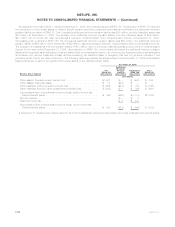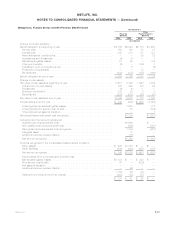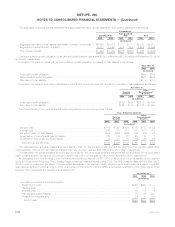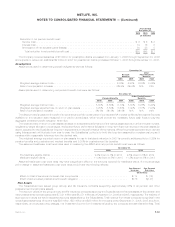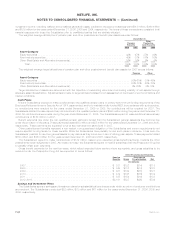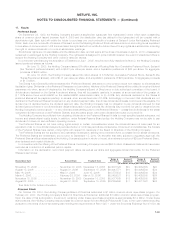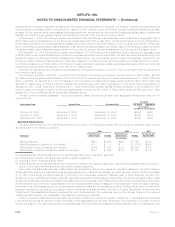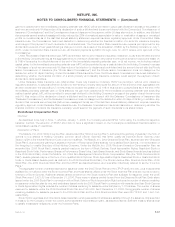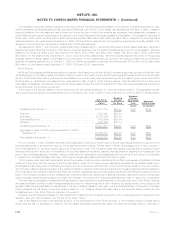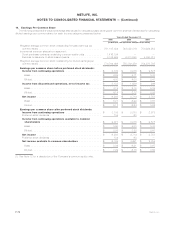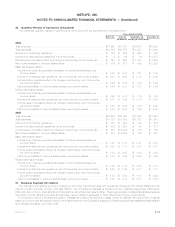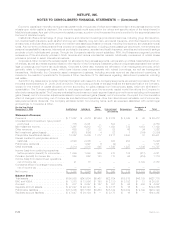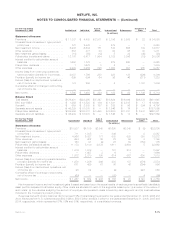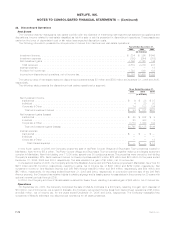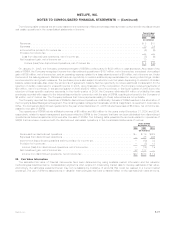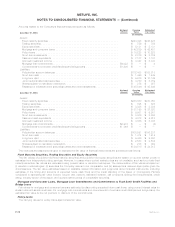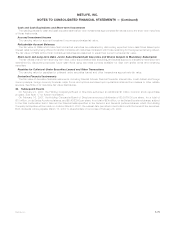MetLife 2006 Annual Report Download - page 153
Download and view the complete annual report
Please find page 153 of the 2006 MetLife annual report below. You can navigate through the pages in the report by either clicking on the pages listed below, or by using the keyword search tool below to find specific information within the annual report.
determined by the product of the initial target multiplied by a factor of 0.0 to 2.0. The factor applied is based on measurements of the
Holding Company’s performance with respect to: (i) the change in annual net operating earnings per share, as defined; and (ii) the
proportionate total shareholder return, as defined, with reference to the three-year performance period relative to other companies in the
S&P Insurance Index with reference to the same three-year period. Performance Share awards will normally vest in their entirety at the end
of the three-year performance period (subject to certain contingencies) and will be payable entirely in shares of the Holding Company’s
common stock.
The following is a summary of Performance Share activity for the year ended December 31, 2006:
Performance
Shares
Weighted Average
Grant Date
Fair Value
Outstanding at January 1, 2006 . . . . . . . . . . . . . . . . . . . . . . . . . . . . . . . . . . . . . . . . . . 1,029,700 $36.87
Granted........................................................ 884,875 $48.43
Forfeited ....................................................... (65,000) $41.37
Outstanding at December 31, 2006 . . . . . . . . . . . . . . . . . . . . . . . . . . . . . . . . . . . . . . . 1,849,575 $42.24
Performance Shares expected to vest at December 31, 2006 . . . . . . . . . . . . . . . . . . . . . . 1,820,742 $42.16
Performance Share amounts above represent aggregate initial target awards and do not reflect potential increases or decreases
resulting from the final performance factor to be determined at the end of the respective performance period. None of the Performance
Shares vested during the year ended December 31, 2006.
Performance Share awards are accounted for as equity awards but are not credited with dividend-equivalents for actual dividends paid
on the Holding Company’s common stock during the performance period. Accordingly, the fair value of Performance Shares is based upon
the closing price of the Holding Company’s common stock on the date of grant, reduced by the present value of estimated dividends to be
paid on that stock during the performance period.
Compensation expense related to initial Performance Shares granted prior to January 1, 2006 and expected to vest is recognized
ratably during the performance period. Compensation expense related to initial Performance Shares granted on or after January 1, 2006
and expected to vest is recognized ratably over the performance period or the period to retirement eligibility, if shorter. Performance Shares
expected to vest and the related compensation expenses may be further adjusted by the performance factor most likely to be achieved, as
estimated by management, at the end of the performance period. Compensation expense of $74 million and $24 million, related to
Performance Shares was recognized for the years ended December 31, 2006 and 2005, respectively.
As of December 31, 2006, there was $59 million of total unrecognized compensation costs related to Performance Share awards. It is
expected that these costs will be recognized over a weighted average period of 1.59 years.
Long-Term Performance Compensation Plan
Prior to January 1, 2005, the Company granted stock-based compensation to certain members of management under the LTPCP. Each
participant was assigned a target compensation amount (an “Opportunity Award”) at the inception of the performance period with the final
compensation amount determined based on the total shareholder return on the Holding Company’s common stock over the three-year
performance period, subject to limited further adjustment approved by the Holding Company’s Board of Directors. Payments on the
Opportunity Awards are normally payable in their entirety (subject to certain contingencies) at the end of the three-year performance period,
and may be paid in whole or in part with shares of the Holding Company’s common stock, as approved by the Holding Company’s Board of
Directors. There were no new grants under the LTPCP during the years ended December 31, 2006 and 2005.
A portion of each Opportunity Award under the LTPCP is expected to be settled in shares of the Holding Company’s common stock
while the remainder will be settled in cash. The portion of the Opportunity Award expected to be settled in shares of the Holding Company’s
common stock is accounted for as an equity award with the fair value of the award determined based upon the closing price of the Holding
Company’s common stock on the date of grant. The compensation expense associated with the equity award, based upon the grant date
fair value, is recognized into expense ratably over the respective three-year performance period. The portion of the Opportunity Award
expected to be settled in cash is accounted for as a liability and is remeasured using the closing price of the Holding Company’s common
stock on the final day of each subsequent reporting period during the three-year performance period.
Compensation expense of $14 million, $46 million and $49 million, related to LTPCP Opportunity Awards was recognized for the years
ended December 31, 2006, 2005 and 2004, respectively.
The aggregate fair value of LTPCP Opportunity Awards outstanding at December 31, 2006 was $41 million, all of which has been
recognized. LTPCP Opportunity Awards with an aggregate fair value of $65 million vested during the year ended December 31, 2006, and
settled in the form of 906,989 shares and $16 million in cash. It is expected that approximately 760,000 additional shares and $15 million in
cash will be issued in future settlement of LTPCP Opportunity Awards expected to become payable in the second quarter of 2007.
StatutoryEquityandIncome
Each insurance company’s state of domicile imposes minimum risk-based capital (“RBC”) requirements that were developed by the
National Association of Insurance Commissioners (“NAIC”). The formulas for determining the amount of RBC specify various weighting
factors that are applied to financial balances or various levels of activity based on the perceived degree of risk. Regulatory compliance is
determined by a ratio of total adjusted capital, as defined by the NAIC, to authorized control level RBC, as defined by the NAIC. Companies
below specific trigger points or ratios are classified within certain levels, each of which requires specified corrective action. Each of the
Holding Company’s U.S. insurance subsidiaries exceeded the minimum RBC requirements for all periods presented herein.
The NAIC adopted the Codification of Statutory Accounting Principles (“Codification”) in 2001. Codification was intended to standardize
regulatory accounting and reporting to state insurance departments. However, statutory accounting principles continue to be established
F-70 MetLife, Inc.
METLIFE, INC.
NOTES TO CONSOLIDATED FINANCIAL STATEMENTS — (Continued)


